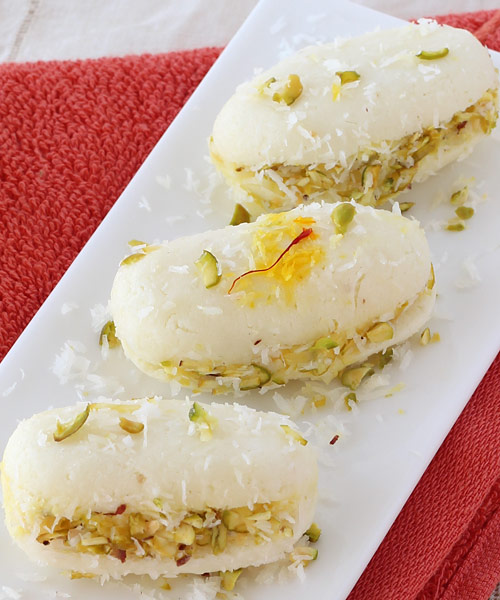In the rich tapestry of Indian cuisine, sweets occupy a cherished corner. One such gem is the beloved “Cham Cham,” a delectable confection that has captured the hearts and palates of people across the country. This exquisite dessert is an embodiment of the culinary artistry that India is renowned for, boasting a perfect blend of flavors, textures, and cultural significance. In this exploration, we delve into the nuances of Cham Cham, its cultural significance, and a comprehensive recipe that unveils the secrets behind this heavenly treat.
Cham Cham, also known as “Chomchom” or “Chum Chum,” hails from the Indian state of West Bengal, where it is celebrated not just as a dessert but as an integral part of festivals, celebrations, and joyous occasions. Its name is derived from the word “Cham,” which means to “squeeze” or “press lightly.” This etymology is apt, as Cham Cham is made by kneading paneer (Indian cottage cheese) into soft cylindrical shapes before soaking them in a fragrant sugar syrup. This simple yet intricate process results in a sweet that is both visually appealing and utterly indulgent.
The process of crafting Cham Cham is an art that requires precision and care. The main ingredient, paneer, is obtained by curdling milk and separating the curds from the whey. The curds are then drained and kneaded until they attain a smooth and pliable consistency. This kneading is crucial as it directly influences the texture of the final product. Once the paneer is ready, it is divided into small portions and rolled into oblong shapes, reminiscent of small logs.
The sugar syrup, infused with aromatic ingredients such as cardamom and saffron, is the soul of Cham Cham. The paneer logs are gently poached in this syrup, allowing them to absorb its flavors and become infused with sweetness. The heat must be maintained at a gentle simmer to prevent the Cham Cham from disintegrating or becoming rubbery. Patience is key here, as the logs require time to absorb the syrup and swell slightly, resulting in a tender and succulent texture.
The Cham Cham’s charm also lies in its versatility. While the classic version is a pristine white, resembling ivory, variations include those adorned with a dusting of pistachios, almonds, or even coconut flakes. The garnishes not only enhance the visual appeal but also introduce diverse textures and flavors, creating a symphony of sensations with each bite.
The cultural significance of Cham Cham goes beyond its delectable taste. It is deeply rooted in the traditions of West Bengal, especially during the iconic festival of Navratri, where it is offered as prasad (divine offering) in temples and shared among devotees. The sweet’s inviting aroma and the way it delicately melts in the mouth are symbolic of the blessings and sweetness that life has to offer.
Now, let’s embark on a journey through the recipe that brings this culinary masterpiece to life. The process can be divided into three main stages: preparing the paneer, shaping the Cham Cham, and creating the sugar syrup.
Ingredients:
For Paneer:
- 1 liter full-fat milk
- 2-3 tablespoons lemon juice or vinegar
For Sugar Syrup:
- 2 cups sugar
- 4 cups water
- A pinch of saffron strands
- 4-5 green cardamom pods, crushed
For Garnish (optional):
- Chopped pistachios, almonds, or coconut flakes
Instructions:
-
Preparing Paneer:
- In a large pot, bring the milk to a boil.
- Add lemon juice or vinegar gradually while stirring, until the milk curdles and the whey separates.
- Strain the curdled milk through a muslin cloth. Rinse it under cold water to remove any lemony flavor.
- Gather the cloth and hang it for about 1 hour to drain excess water. This will yield soft and crumbly paneer.
-
Shaping Cham Cham:
- Knead the paneer on a smooth surface until it becomes smooth and pliable.
- Divide the paneer into small portions and roll them into oblong shapes, about 2-3 inches long.
- Press each portion lightly between your palms to flatten the sides and create a cylindrical shape.
-
Creating Sugar Syrup:
- In a wide pot, combine sugar and water. Bring it to a boil, stirring until the sugar dissolves.
- Add saffron strands and crushed cardamom pods to the syrup. Let it simmer for a few minutes to infuse the flavors.
-
Cooking Cham Cham:
- Gently slide the paneer logs into the simmering sugar syrup.
- Cover the pot with a lid and let the Cham Cham cook on low heat for about 15-20 minutes. Occasionally, turn them over to ensure uniform soaking.
- The Cham Cham will expand slightly and become soft to the touch when they are ready.
-
Finishing Touches:
- Allow the Cham Cham to cool in the syrup. As they cool, they will absorb more of the sugar syrup, becoming even more flavorful.
- Once cooled, remove the Cham Cham from the syrup and gently roll them in chopped pistachios, almonds, or coconut flakes, if desired.
The Cham Cham is now ready to grace your table with its ethereal presence. Each bite is a celebration of the skillful artistry and the vibrant culture that has contributed to its creation. As you savor its softness, the fragrant syrup, and the delightful garnishes, you partake in a journey that extends beyond taste to the heart of Indian tradition.
In conclusion, Cham Cham is a remarkable testament to the craftsmanship and creativity present in Indian sweets. From its humble beginnings in West Bengal to becoming a beloved treat cherished across the nation, this dessert has captured the essence of celebrations, family gatherings, and joyful moments. Its recipe, though intricate, rewards those who undertake it with a creation that transcends taste to evoke emotions and memories deeply rooted in the fabric of India’s culinary heritage.

